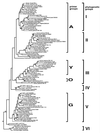Wide distribution and diversity of members of the bacterial kingdom Acidobacterium in the environment
- PMID: 10103274
- PMCID: PMC91244
- DOI: 10.1128/AEM.65.4.1731-1737.1999
Wide distribution and diversity of members of the bacterial kingdom Acidobacterium in the environment
Abstract
To assess the distribution and diversity of members of the recently identified bacterial kingdom Acidobacterium, members of this kingdom present in 43 environmental samples were surveyed by PCR amplification. A primer designed to amplify rRNA gene sequences (ribosomal DNAs [rDNAs]) from most known members of the kingdom was used to interrogate bulk DNA extracted from the samples. Positive PCR results were obtained with all temperate soil and sediment samples tested, as well as some hot spring samples, indicating that members of this kingdom are very widespread in terrestrial environments. PCR primers specific for four phylogenetic subgroups within the kingdom were used in similar surveys. All four subgroups were detected in most neutral soils and some sediments, while only two of the groups were seen in most low-pH environments. The combined use of these primers allowed identification of a novel lineage within the kingdom in a hot spring environment. Phylogenetic analysis of rDNA sequences from our survey and the literature outlines at least six major subgroups within the kingdom. Taken together, these data suggest that members of the Acidobacterium kingdom are as genetically and metabolically diverse, environmentally widespread and perhaps as ecologically important as the well-known Proteobacteria and gram-positive bacterial kingdoms.
Figures

References
-
- Anderson R T, Rooney-Varga J N, Gaw C V, Lovely D R. Anaerobic benzene oxidation in the Fe(III) reduction zone of petroleum-contaminated aquifers. Environ Sci Technol. 1998;32:1222–1229.
-
- Barns S M, Busch J D, Kuske C R. Abstracts of the 97th General Meeting of the American Society for Microbiology 1997. Washington, D.C: American Society for Microbiology; 1997. Molecular characterization of pinyon pine-associated soil microbial communities at Sunset Crater, AZ, abstr. N-198; p. 413.
Publication types
MeSH terms
Substances
Associated data
- Actions
LinkOut - more resources
Full Text Sources
Molecular Biology Databases

